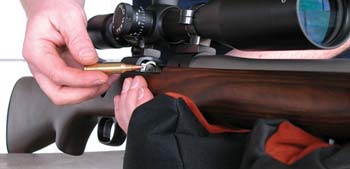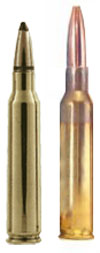What you need to know about ammunition
by Peter Cuddy
Hunter 11
Included on commercial ammunition is generally a warning such as: ‘To avoid serious injury/death to shooters and bystanders, use only firearms in good condition with markings exactly matching ammunition.’ This is OK, as long as the ammunition is in the original factory packets, but quite often bulk lots of ammo are available at reduced prices - usually ex-military fodder - and therefore may not be labelled
 Shooters need to check the head stamps to ensure they are purchasing
the correct calibre and type for their firearm. Many military
cartridges are similar in appearance, but may be different in calibre
and some do not have the cartridge identification on the head.
Shooters need to check the head stamps to ensure they are purchasing
the correct calibre and type for their firearm. Many military
cartridges are similar in appearance, but may be different in calibre
and some do not have the cartridge identification on the head.
Once, as a range officer at the busy Anzac Range in Sydney, I came across two incidents where a shooter tried to load incorrect ammunition into a rifle during military/service matches. Luckily, in both these cases, the bolt would not close so a shot was not taken. These two gentlemen could have experienced serious injury if the calibres they were using had been different.
Military rifle ammunition is not always well marked and often has been repacked, sometimes in different calibre ammunition boxes. In the first of these two instances, our erstwhile bargain hunter had bought ‘a bargain’ at a recent gun show and was busily loading these bargain cartridges from the packet, which said 6.5x55 Swedish Mauser, into a rifle of that calibre. However, the cartridges were in fact .308 Winchester (7.62x51 NATO) that had been repacked into the 6.5 Swedish box.
 In the second instance, the shooter was on the line loading ammunition
from clips in a cloth bandolier into a .303 service rifle. It turned
out that there was an 8mm Mauser round loaded into one of the clips,
which the shooter was having ‘difficulty’ chambering. Having a rogue
8mm Mauser round really starts the alarm bells ringing, as many a
.30-06 rifle has been blown up by having an 8mm Mauser round loaded and
fired in it.
In the second instance, the shooter was on the line loading ammunition
from clips in a cloth bandolier into a .303 service rifle. It turned
out that there was an 8mm Mauser round loaded into one of the clips,
which the shooter was having ‘difficulty’ chambering. Having a rogue
8mm Mauser round really starts the alarm bells ringing, as many a
.30-06 rifle has been blown up by having an 8mm Mauser round loaded and
fired in it.
It is well-documented in many firearm reference books how incorrect ammunition can be loaded into certain firearms with catastrophic results. The 8mm Mauser in the .30-06 and a 20-gauge shotgun shell into a 12-gauge are two of the most commonly described mistakes, but they are not the only possible incorrect combinations.
Indeed there are other unfortunate combinations, such as a .222 Remington being loaded into a .223 Remington rifle and a .223 being loaded into a .224 Remington Magnum.
As a shooter, you need to think seriously about the ammunition you use. Here are a few important things you need to know about ammunition:
- Know how to identify the correct ammunition for the firearms that you own or are using.
- Do not mix ammunition of different calibres.
- If you are not sure what calibre a cartridge is, put it aside until you can find someone who is competent to properly identify it for you. Keep it separated from any ammunition you intend to use.
- Keep ammunition clean.
- Keep ammunition in containers that are well marked with the correct description.
- Before going onto the range or into the field, double check that you have the correct ammunition for the firearms that you intend to use. Make sure that it is clearly marked and that there are no ‘ring-ins’.
- Store ammunition separately from firearms.
- The warnings on commercial ammunition packs is important; read them.
- If in doubt about any ammunition, don’t use it.
- Ammunition doesn’t like heat. It is a dangerous practice to leave ammunition exposed for long periods in direct sunlight, as this can cause high pressures to develop on firing.
- Ammunition should always be stored in cool dry places. Prolonged storage in warm places can cause primers to become de-activated or can cause the propellant powders to break down.
- Keep ammunition away from a fire. Fire can cause cartridge cases to burst and add to the fire. However, you should know that small arms ammunition is UN Class 1.4S and not liable to explode in bulk.
- Do not try and clean dirty or rusty ammunition with solvents or preservatives such as WD 40. These will destroy your ammunition.
In most cases, commercial ammunition is clearly identifiable purely by reading the headstamp, which is the marking on the head or base of the cartridge case; however, some ammunition may have been reloaded or reformed to another calibre. Military ammunition is often difficult to decipher; therefore, you need to know how to identify the physical characteristics of ammunition for the firearms that you intend to use.
Remember, if you are in doubt about any ammunition, ask someone experienced in the area. Your SSAA range officers are generally skilled in correctly identifying ammunition or can suggest a competent person to assist you. Also, remember to check that every cartridge is correct for the firearm you are intending to use.
